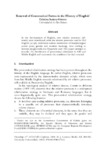Mostrar o rexistro simple do ítem
Renewal of Grammatical Forms in the History of English
| dc.contributor.author | Suárez-Gómez, Cristina | |
| dc.date.accessioned | 2016-07-15T08:35:25Z | |
| dc.date.available | 2016-07-15T08:35:25Z | |
| dc.date.issued | 2008 | |
| dc.identifier.citation | AEDEAN 2008, 31: 303-312 ISBN-978-84-9749-278-2 | |
| dc.identifier.isbn | 978-84-9749-278-2 | |
| dc.identifier.uri | http://hdl.handle.net/2183/17045 | |
| dc.description.abstract | [Abstract] In the development of English, new relative pronouns (whwords) were introduced, while the relative pronouns used in Old English (se/seþe) underwent various restrictions of morphological nature (case, gender and number marking), thus tending to become progressively less frequently used. This paper attempts to describe the distribution of pronominal relativizers in Old and Middle English and reconstruct the conditions for their renewal. | |
| dc.language.iso | eng | |
| dc.publisher | Universidade da Coruña | |
| dc.title | Renewal of Grammatical Forms in the History of English | |
| dc.type | info:eu-repo/semantics/conferenceObject | |
| dc.rights.access | info:eu-repo/semantics/openAccess |






